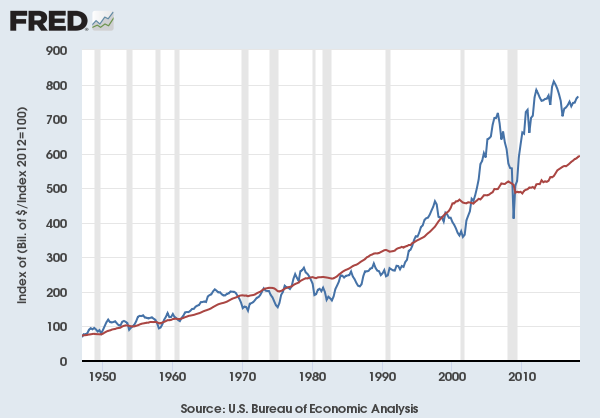Democracy Against Capitalism: Conclusion Part 2
Index to all posts in this series.
The Marxist views of Ellen Meiksins Wood in Democracy Against Capitalism give a bleak picture of capitalism which I contrasted with the view offered by Bruce Scott, the Paul Whiton Cherington Professor of Business Administration, Emeritus, at the Harvard Business School. Scott’s paper, The Political Economy of Capitalism is apparently a draft of a chapter of a book he wrote titled Capitalism: Its Origins and Evolution as a System of Governance. The book is available here.
The paper gives a picture of capitalism as an organic system that evolves as it encounters new things, rather than as a physical system, one subject to the laws of physics and chemistry. Scott calls capitalism a form of indirect governance of the economy. Here’s an extended quote from the paper that gives a fair picture.
Capitalism, as I define the term, is an indirect system of governance based on a complex and continually evolving political bargain in which private actors are empowered by a political authority to own and control the use of property for private gain subject to a set of laws and regulations. Workers are free to work for wages, capital is free to earn a return, and both labor and capital are free to enter and exit from various lines of business. Capitalism relies upon the pricing mechanism to balance supply and demand in markets; it relies on the profit motive to allocate opportunities and resources among competing suppliers; and it relies upon a political authority (government) to establish the rules and regulations so that they include all appropriate societal costs and benefits. Government and its agents are held accountable to provide physical security for persons and property as well as the laws and regulations. Capitalist development is built from investment in new technologies that permit increased productivity, where a variety of initiatives are selected through a Darwinian process that favors productive uses of those resources, and from the periodic modernization of the legal and regulatory framework as indicated by changing market conditions and societal priorities. Capitalist development requires that government play two roles, one administrative, in providing and maintaining the institutions that underpin capitalism, and the other entrepreneurial, in mobilizing power to modernize these institutions as needed.
I leave it as an exercise for the reader to work out the wide variances between his conceptualization of capitalism and real live capitalism. I will only point out the most obvious problem: the externalities of pollution are not corrected by any regulation or law, efforts to do so have been struck down by the courts, and the coming disaster cannot and will not be fixed by capitalism.
In the book, Scott says that he was dissatisfied with existing histories of capitalism because they were observational rather than explanatory. What he found lacking was human agency. This book is his attempt to incorporate human agency into the history of the evolution of capitalism.
When human agency is taken into account, the story of US industrial development in the 19th century becomes one of competition between those who wanted to empower firms to grow and become more productive and inevitably more powerful politically as well as economically, and those who wished to establish a regulatory framework to protect the public from the abuse of private power by those same firms, for instance, through regulation of railroad rates and/or by restricting the rights of firms to grow through mergers and acquisitions. P. xxi.
Scott claims that our current system features two systems of government, one for the economy and one for all other matters. The economy is managed by private interests, under rules and laws created by the central authority and by intermediary institutions. He calls this indirect governance of the economy. The other part of society is governed directly by the central authority. He identifies a three tier system of governance for the economy, using a sports analogy. In Olympic sports, there are the athletes and the games at one level, the governing bodies of the sports at another, and the top tier is occupied by the Olympics organization. By analogy, there are business firms at the first level of the economy, then institutional foundations, such as regulatory authorities, and then the elected officials at the third level.
In sports, as indeed in capitalism, political authorities play two distinct roles: one administrative, in maintaining the existing system of playing fields and enforcing the existing rules, and the second entrepreneurial, in mobilizing power to win the needed votes in the legislature in order to admit new teams, change the locations or timing of competition, change the rules and regulations, and/or change the distribution of revenues. Book, p. 50.
It’s possible to see the US system of capitalism as Scott describes it, at least in abstract theoretical terms. I don’t think he has solved the human agency question correctly. At least in the parts I’ve read so far, Scptt doesn’t discuss power relations in capitalism. For Wood, power relations are central to capitalism. She identifies those relations as the social relations between producers and capitalists: domination, exploitation and appropriation. Compare that with the description in the quote from Scott’s paper above: workers are free to work for wages (or not), capitalists are free to invest seeking a return (or not). What happens to workers who don’t work for wages? What happens to capitalists who don’t invest? The different outcomes are obvious: the workers starve, and the capitalists lives off their money.
Scott also understates the problems created by the power of the capitalists inside the organizational structure he describes. He is clear that capitalists have the ability to lobby, buy politicians and regulators and courts, and to rig the system in their favor. He recognizes that some of the gains of capitalists are the result of the “deliberate distortion of [market] frameworks for private advantage” but calls them by the bloodless term “externalities”. From the paper:
While small imperfections can be overlooked as acceptable aspects of an imperfect process, large, deliberate distortions for private gain are likely to add to the income inequalities in the society, creating and/or sustaining a vicious circle in which the markets serve as a way for the rich to exploit the poor. On the other hand, if a poor majority were to take political power in a country or region it could use that political power to shape institutions to disadvantage the rich, including to take their property.
Fear of letting the poor have a significant role in government has motivated the dominant classes throughout history, with few concrete examples of the horrible possiblity of losses by the rich.
And I’ll say again, capitalism isn’t going to fix the coming planetary disaster. In fact it’s going to make it worse by insisting on pumping more carbon dioxide and other chemicals into our environment. The continued profitability of huge swathes of the economy depends on it. As long as the economy is governed solely by the profit motive, there can be no solution.
Update.
Commenter Anon raises an interesting question: can the bloodless quality of Bruce Scott’s account of capitalism be attributed to Scott’s life work in the Harvard Business School. There is a partial answer in the Preface, which may be the single most useful preface I have ever read. He describes the evolution of his ideas, complete with the names of individuals, including his research associates, who helped him formulate them, and books and experiences that were important.
For those interested, this is worth reading, and I have a better understanding of the question Anon raises. In short, I think Scott has a framework grounded in standard economics and standard political science. He works at moving away from it, as is evident in his flat rejection of neoliberalism (he doesn’t use that term), as well as by his clear affinity for a form of capitalism. Thus, he finds himself in the gap between the structured views of capitalism we see in Wood, and the materials he found useless or dead wrong. He wants to construct a different view, but he tries to salvage as much as possible of the views he’s always held.
I’ll add a discussion of the similarities between Scott and Wood in the next part of this extended conclusion.


